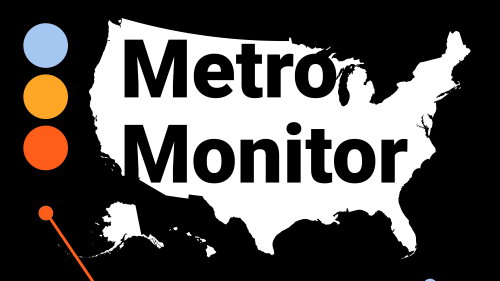This analysis accompanies Metro Monitor 2023, a data interactive that provides decisionmakers in the nation’s 192 largest metro areas with a roadmap to understand how their individual places performed during this period.
Since the onset of the COVID-19 pandemic, the United States has gone through an acute recession in 2020, a rapid jobs recovery in 2021, and high and sustained inflation in 2022.
To measure how local economies were faring during one of the most volatile economic periods in recent memory, Brookings Metro launched the Metro Recovery Index in 2020. It included critical insights on certain elements of economic recovery, including jobs, home prices, rents, and commuting patterns. But data was not yet available to measure whether the gains of the recovery were being shared inclusively across people and places.
Now, three years since the beginning of the pandemic, our newly released Metro Monitor provides the first comprehensive look of how the crisis impacted inclusive growth across 192 U.S. metro areas with populations of at least 250,000.
Metro areas experienced four types of inclusive growth trajectories during the pandemic
The Metro Monitor examines economic performance across five broad categories: growth, prosperity, overall inclusion, racial inclusion, and geographic inclusion. Each category is measured using three standardized indicators. To assess how the pandemic influenced inclusive growth, this analysis examines trends across those indicators over two time periods: pre-pandemic (2011 to 2019) and during the pandemic (2019 to 2021). Due to data availability issues, we are unable to examine the Metro Monitor’s fifth category (geographic inclusion) across the 2019 to 2021 period.
We created a composite “inclusive growth score” by combining performance across the 12 total indicators for each period. We then rank-ordered the 192 metro areas over the two time periods and compared their performance between pre-pandemic and during the pandemic. A single score helps compare performance comprehensively and over time, and our methodology seeks to reward metro areas that achieved broad-based improvement across most indicators (see Appendix A). That noted, because metro area trends vary across the economic performance categories, we encourage readers to also consult our interactive, which breaks out the data across all five categories.
This analytical approach reveals a diverse landscape of metro area performance, exemplified by four distinct inclusive growth trajectories:
- “Resilient” metro areas had an inclusive growth score that ranked in the top half of metro areas in both periods, meaning they were strong performers prior to the pandemic and were able to sustain that relatively strong performance through the crisis. Fifty metro areas were “Resilient.”
- “Emergent” metro areas ranked in the bottom half for inclusive growth pre-pandemic, but in the top half during the pandemic. Forty-five metro areas were “Emergent.”
- “Tested” metro areas inverted the experience of “Emergent” metro areas. These places ranked in the top half in the pre-pandemic period, but slipped into the bottom half during the pandemic. Forty-five metro areas were “Tested.”
- “Stagnant” metro areas had an inclusive growth score that ranked in the bottom half of the sample in both periods. Fifty-two metro areas were “Stagnant.”
The remainder of this analysis examines pre-pandemic and pandemic-era inclusive economic performance by metro size and region. We group metro areas into three size categories: 56 “very large” metro areas with populations above 1 million; 57 “large” metro areas with populations between 500,000 and 1 million; and 79 “midsized” metro areas with populations between 250,000 and 500,000. We also group metro areas across the four major census regions (South, West, Midwest, and Northeast) to explore geographic trends.
Large metro areas performed better on inclusive growth than very large metro areas and midsized metro areas
The economic cycle between the Great Recession and COVID-19 recession was defined by increasing concentration of economic activity in the nation’s very large metro areas (those with populations greater than 1 million). From 2011 to 2019, very large metro areas outpaced the rest of the nation on job creation, wage gains, and median earnings growth. And while these metro areas did not fully close their economic and racial disparities, those gaps were beginning to narrow alongside rising growth and prosperity. Indeed, in the pre-pandemic period, seven in 10 very large metro areas had a composite inclusive growth score that ranked in the top half of all 192 metro areas.
The health and economic crises in 2020 and 2021 uniquely tested very large metro economies, reversing their long-term trend. During the pandemic period, very large metro areas suffered a greater relative loss in overall jobs, jobs at young firms, and employment rates than large metro areas (those with populations between 500,000 and 1 million) and midsized metro areas (those with populations between 250,000 and 500,000). And the relative poverty rate gap between non-Latino or Hispanic white people and people of color increased more in very large metro areas than other metro areas from 2019 to 2021.
Adding it all up, over 40% of very large metro areas landed in the “Tested” category, meaning their inclusive growth performance fell from the top half to the bottom half of metro areas from the pre-pandemic to the pandemic period. “Tested” metro areas included some of the largest, most dynamic economies in the country, including New York, Los Angeles, San Francisco, Seattle, Atlanta, Boston, and San Diego. For many years, it appeared nothing could dent the economic momentum in these major hubs of technology and commerce, but the pandemic did so significantly.
Between 2019 and 2021, very large metro areas’ losses appeared to be large metro areas’ gains. Two-thirds of large metro areas were either “Resilient” or “Emergent,” meaning they performed as well or better on inclusive growth during the pandemic than pre-pandemic. Among the three size categories, median earnings grew fastest in large metro areas. Places such as Durham, N.C.; Portland, Maine; Knoxville, Tenn.; and Colorado Springs, Colo.—each adjacent to a very large metro area—experienced particularly striking relative performance improvements during the pandemic.
Midsized metro areas exhibited more mixed performance. About 35% of midsized metro areas were “Stagnant,” meaning they performed in the bottom half of metro areas on inclusive growth in both periods. Midsized economies that specialize in oil and gas in the South often landed in this category, as did many Northeast communities such as Atlantic City, N.J. and Norwich, Conn. Notwithstanding these challenges, there were bright spots for midsized metro areas, especially if they were adjacent to larger metro areas. This pattern was exemplified by “Emergent” midsized metro areas such as Manchester, N.H. (outside Boston); Kennewick, Wash. (outside Seattle); and Fort Collins, Colo. (outside Denver).
Metro areas in the South proved resilient, those in the West were tested, Midwest metro areas emerged, and Northeast metro areas stagnated
As our colleague William H. Frey has catalogued over the past two decades, the United States has been undergoing long-term shifts in population and economic activity toward the South and West. With some exceptions, the COVID-19 pandemic did not alter these broader trends.
In the South, 31% of metro areas had a “Resilient” performance, meaning their inclusive growth score ranked in the top half of the distribution in both periods. Florida exemplifies this trend. Eleven of the state’s 16 metro areas with more than 250,000 people were in the “Resilient” category—even the communities most impacted by major hurricanes over the last decade, such as Port St. Lucie and Crestview-Fort Walton-Destin. The South was not without challenges, however. Local economies reliant on the oil and gas sector in Texas and Louisiana struggled. The only four Texas metro areas to land in the “Resilient” category (Austin, Dallas, Waco, and College Station) tend to specialize in technology, business services, and educational services—not energy.
In the West, 71% of metro areas had above-average inclusive growth scores in the pre-pandemic period—a result of strong gains in GDP, employment, and wages across the region. The pandemic separated these metro areas along two trajectories. Metro economies such as Boise, Idaho; Boulder, Colo.; Fresno, Calif.; Sacramento, Calif.; and Ogden, Provo, and Salt Lake City in Utah posted some of the highest inclusive growth scores in the nation. But the pandemic tested inclusive economic growth in many of the most historically robust western metro economies, including Denver, Portland, Ore., San Diego, San Francisco, and Seattle. San Francisco dropped from fourth place in our composite inclusive growth score during the pre-pandemic period to 109th in the pandemic period. Seattle went from third place to 97th; Los Angeles went from 34th to 165th; and Denver went from eighth to 121st.
About 60% of Midwest metro areas performed in the bottom half of our inclusive growth ranking in the 2011 to 2019 period. Half of those metro areas jumped into the top half of the distribution during the pandemic. These “Emergent” metro areas included affordable regional business centers such as Cincinnati, Cleveland, Indianapolis, and Kansas City, Mo. But the other 30% of Midwest metro areas fell into the “Stagnant” category, suggesting the pandemic has not fundamentally altered many of the inclusive growth challenges the region has experienced since the Great Recession. This was particularly true for the region’s midsized metro areas, nearly three-quarters of which were categorized as “Stagnant.”
Meanwhile, 43% of Northeast metro areas were in the “Stagnant” category, including three out of the four metro areas in Connecticut, both metro areas in southern New Jersey, and Springfield, Mass. Northeastern metro areas posted smaller GDP growth than peers in the other three regions, and recovered a far lower share of the jobs lost during the pandemic. This employment deficit and stagnant output drove down the region’s productivity and standard-of-living metrics. Northeastern labor markets also experienced widening racial gaps: More than half of metro areas in the Northeast have experienced worsening employment disparities between white residents and people of color since 2019.
Figure 3
Inclusive economic performance varied spatially during the pandemic
What will be the lasting impact of the pandemic on metro economies?
The data from this year’s Metro Monitor tracks how local economies navigated the economic effects of the COVID-19 pandemic and recession, offering the clearest picture to-date of the lingering impact of the crisis on people and communities. Accompanying this post, the Metro Monitor data interactive provides decisionmakers in the nation’s 192 largest metro areas with a roadmap to understand how their individual places performed during this period.
The shifts in metro area inclusive growth trajectories this analysis examines warrant continued monitoring in the coming months and years. The pandemic knocked very large metro areas off their long-term inclusive growth trajectory. Given their large contributions to national growth and prosperity, whether they can bounce back in the coming years will matter greatly to the overall U.S. economy. Large metro areas performed better in the pandemic period, but can they sustain this growth and ensure it is broadly shared? And what is the economic future for midsized regions, especially those in the Midwest and Northeast that remained economically stagnant across both periods and are seeing diminished populations and economic activity?
Overall, the trends outlined in this report suggest that the pandemic significantly altered the spatial pattern of inclusive growth in America. The durability of these changes to the nation’s geographic landscape of economic opportunity will a question of fundamental import in the coming years.
The Brookings Institution is committed to quality, independence, and impact.
We are supported by a diverse array of funders. In line with our values and policies, each Brookings publication represents the sole views of its author(s).









